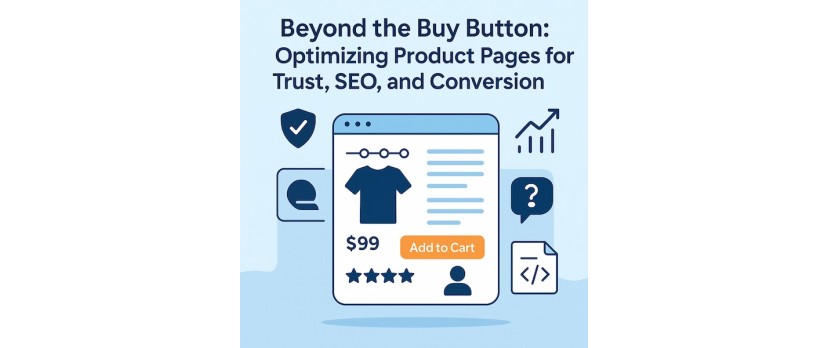In ecommerce, most businesses focus on traffic acquisition - whether through ads, SEO or email marketing. But a quiet powerhouse sits at the heart of every online store: the product page. It’s where intent meets decision. Yet many stores underutilize this asset, treating it as a digital shelf label instead of a trust-building, conversion-driving engine.
This article will explore the evolving role of product pages in ecommerce success. We’ll look at how to turn these pages from static listings into dynamic trust-builders, optimized for both search engines and human behaviour.
1. The Old vs. New Model of Product Pages
Traditional product pages follow a basic structure: image gallery, price, short description and a Buy Now button. That might have worked during the early days of ecommerce but consumer expectations have changed.
Today’s consumers are wary. With scams, dropshipping delays and product misrepresentation on the rise, they look for trust signals. A modern product page must do more than inform - it must reassure, persuade and often entertain.
Modern product pages should address three things:
Discovery (SEO and structured data)
Trust (social proof, quality UX, transparency)
Decision-making (comparison tools, FAQs, guarantees)
2. Search Engines Love Structured, Intent-Rich Pages
Search engines no longer just index product names and prices. With natural language processing, semantic markup and E-E-A-T (Experience, Expertise, Authoritativeness, Trustworthiness), Google now favours product pages that:
Have detailed, unique product descriptions
Feature first-party reviews
Use structured schema (Product, Review, FAQ, Breadcrumb)
Are part of a thematically relevant internal linking structure
For example, if you’re selling waterproof jackets, it’s no longer enough to title the page “Black Waterproof Jacket – Size M”. Instead, enrich the page with related FAQs like “How to clean a waterproof jacket?”, usage scenarios (“Perfect for Scottish hillwalks or monsoon bike commutes”) and schema markup to help Google surface snippets like reviews and stock levels.
Pro Tip: Use OpenCart extensions or a custom module to integrate structured data automatically into your product template.
3. Product Page UX:
The Trust MultiplierOnce a visitor lands on a product page, the goal is to reduce friction. This doesn’t mean cutting down content - it means guiding their attention.
Key UX elements that build trust and improve conversions:
Crisp, original product images (bonus: include lifestyle shots or videos)
Shipping and returns information above the fold
Trust badges (secure checkout, verified reviews, guarantees)
Live stock indicators (but only if genuine - false urgency backfires)
User-generated reviews with images for authenticity
OpenCart users can implement many of these enhancements with plugins - just be sure to avoid overloading your site with scripts that slow performance.
4. Product Page SEO Hubs
One powerful trend is the use of product pages as mini SEO content hubs.
Imagine you’re selling a home-selling course or a guidebook. You don’t just write a sales page. You also include:
A glossary of relevant terms (“What is equity?”, “What does ‘chain-free’ mean?”)
Internal links to blog articles (“How to sell your house fast in the UK”)
Case studies or testimonials from past clients
This approach turns a single product page into a knowledge-rich experience that ranks for long-tail search queries and keeps visitors engaged.
A good example of this strategy in action is Ready Steady Sell, a UK-based home sale service. Their site doesn’t just pitch the offer - it educates, provides social proof and creates an interlinked ecosystem of resources, increasing organic visibility and reducing bounce.
5. Content is King… But So Is Clarity
Adding more content doesn’t mean cluttering the page. Content needs to be:
Scannable (use headings, bullet points, collapsible sections)
Contextual (e.g., explain why a 30-day return policy matters)
Balanced (avoid long intros that bury the product benefits)
When using OpenCart, make use of tabbed content areas or accordion dropdowns to break long descriptions, size guides, reviews and FAQs into digestible chunks. Tools like SurferSEO or Clearscope can help align product copy with semantic keywords that improve rankings without keyword stuffing.
6. Don’t Forget Post-Purchase Microcopy
Another underappreciated trust factor is post-purchase communication - and this starts with the product page.
Set expectations early:
“Dispatched within 24 hours”* “Packaging is plastic-free and recyclable”
“Track your order via SMS”
When buyers are informed they’ll email support less, leave fewer negative reviews and cancel less. Bonus: this reduces operational overhead.
7. AI and Personalization: The Future is Now
AI-powered product page personalization is already here. Platforms are using visitor behavior, location and past purchases to adjust:
Product copy tone (formal vs. casual)
Highlighted benefits (eco-friendly for green shoppers, speed for urgency-driven buyers)
Trust signals (local testimonials)
OpenCart doesn’t have native AI personalization but you can integrate 3rd-party AI tools to layer this on top. This will be a game-changer in 2025 and beyond as stores compete not just on product but how that product is presented to each user. A great example is The Damp Specialists based in Brighton, Sussex UK. They are using AI to allow customers to upload photos of damp issues around their home, and creating mock up quotes based on the damage that the AI detects.
8. Takeaways: Product Page Checklist for 2025
Here’s a quick checklist to audit or update your product pages:
✅ Unique product title and meta description
✅ Long product description with headings and benefits
✅ Social proof (real reviews, testimonials, images)
✅ Fast-loading images and mobile-friendly layout
✅ Returns, shipping and guarantee info above the fold
✅ Structured data and schema integration
✅ Related blog links or educational resources
✅ Scannable formatting (tabs, dropdowns, bullets)
✅ Upfront communication on delivery
✅ Optional: Personalization or location-based content
Conclusion
Your product page isn’t just a stop on the customer journey - it’s the heart of it. Whether you’re selling physical products, digital downloads or services the product page is where your brand either gains trust or loses it. By focusing on clarity, content and conversion psychology - while layering SEO best practices - you can increase ROI without spending a penny more on traffic.
And remember: sometimes the best ecommerce growth strategy isn’t getting more people to your site. It’s making sure the ones who are already there convert better.


Login and write down your comment.
Login my OpenCart Account